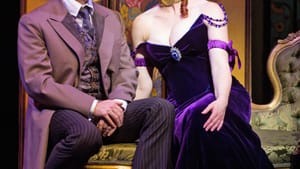Stay in the Loop
BSR publishes on a weekly schedule, with an email newsletter every Wednesday and Thursday morning. There’s no paywall, and subscribing is always free.
I Love Paris
'Can-Can' at Paper Mill Playhouse

Do you have memories of the 1960 movie Can-Can (starring Frank Sinatra, Louis Jourdan, and Shirley MacLaine)?
Wipe them from your mind. This revival is a quite different experience and is far superior. What was insipid on film is exciting in the flesh. The script is sharper, and the fine Cole Porter score is restored (the film omitted much of it) and is superbly sung.
Can-Can had only one Broadway revival in the past 60 years, in 1981 when it folded in two weeks. Decades have passed with the public unable to see the real show.
Few people are around who can remember the original stage production of 1953. I’m here to tell you that this Paper Mill production is better than that one, too. The original had elegant dancing but a creaky plot and stale jokes; the new version has great dancing, a better cast, and far more audience appeal. I was unmoved by the original, in part because I was an adolescent with insufficient appreciation of the Parisian milieu that inspired Cole Porter. More experienced critics of the time dissed it as being below Porter’s high standards.
The show is built around its leading lady, and Kate Baldwin is a superb Pistache, the owner of a nightclub that features scandalous dancing. Baldwin is known to audiences for sweet innocent roles like Sharon in Finian’s Rainbow, Amalia in She Loves Me, and Eliza in My Fair Lady. Here Baldwin is a woman of the world, and she makes the transition compellingly. What’s more, she sings the role better than her predecessors. (The originator was Lilo, a charming French singer whose accent obscured many of the lyrics. MacLaine’s voice inspired so little confidence that the movie’s producers took the show’s best-known song, “I Love Paris,” away from her and assigned it to a choral group. I did not see a 1988 production in London that starred Donna McKechnie and ran approximately two months.)
Can-Can just opened at Paper Mill Playhouse, a venue known for sending its productions to Broadway. Here are additional reasons why this one could make it to New York and be successful there:
- The leading man: Jason Danieley is in peak vocal form as the Parisian magistrate who tries to shut down Pistache’s club and falls in love with her. He is far superior to the originator, Peter Cookson, and to Jourdan, who had the part in the film.
- The supporting cast: Although the plot centers on Pistache and the magistrate, a plethora of colorful supporting players add pleasure. The featured cast members include Michael Berresse as a newspaper critic and womanizer; Michael Kostroff as Jean-Louis, the club’s emcee; Greg Hildreth as Boris, a struggling sculptor; Megan Sikora as Claudine, one of the dancers and Boris’s wife; Mark Price as the poet friend of Boris; and Justin Robertson as Étienne, another Bohemian. All of them have shining moments in the spotlight.
- An improved book: Joel Fields and David Lee have kept the 1890s period and the Abe Burrows narrative and added a backstory for Pistache and the magistrate, plus considerable repartee between the nighclub’s emcee and the theater audience. This involvement with audience members is clever and appealing.
- The music: This is a golden-age show where the songs are the reason for the enterprise. “I Love Paris,”“C’est Magnifique,”“Allez-Vous-En,"”I Am in Love,” and “It’s All Right with Me” are standards that deserve their classic stature. (How many recent shows have five memorable songs?) All the original score is here, and no extraneous numbers have been dragged in from other musicals.
- The lyrics: This must be considered an asset apart from the music because Porter’s sophisticated language and intricate rhymes are a treasure unmatched in the history of American musical theater.
- Choreography: Flashy Parisian dancing is staged with panache by Patti Colombo. Leaps and flips abound, and a version of the bottles-on-their-heads dance, plus the signature can-can.
- Different standards: When new, Can-Can was compared with Porter’s own Kiss Me, Kate and Out of This World, plus new shows by Rodgers and Hammerstein. Now there’s less competition. There’s not going to be anything else by Porter, so his gifts are especially welcome.
A reminder: The can-can was notorious for displaying stockinged thighs but there was, and is, no nudity, and the only curse word is uttered in French; this show is good family entertainment.
What, When, Where
Can-Can. Music and lyrics by Cole Porter. Book by Abe Burrows; revised by Joel Fields and David Lee. Stage direction by David Lee; musical direction by Steve Orich. Through October 26, 2014 at Paper Mill Playhouse, 22 Brookside Drive, Millburn, NJ. 973-376-4343 or www.papermill.org.
Video clip provided by Paper Mill Playhouse.
Sign up for our newsletter
All of the week's new articles, all in one place. Sign up for the free weekly BSR newsletters, and don't miss a conversation.

 Steve Cohen
Steve Cohen